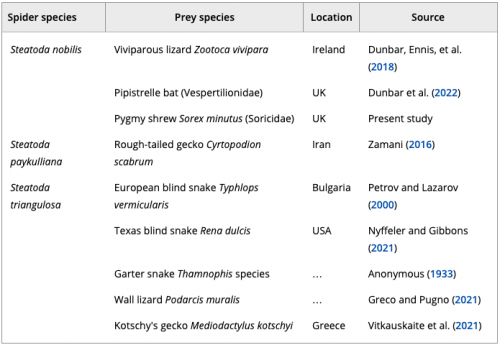Spiders in the genus Theridiidae (and their cousins, Latrodectus) are well known for hunting and eating prey much bigger than they are, including vertebrates. Here’s a vigorous specimen of Steatoda nobilis trussing up a shrew, which she then reduced to skin and bones over the course of three days.
I’m sad to say that we don’t have S. nobilis where I live, but there’s hope — they’re spreading across the country. Our spiders in my region can get fairly big (especially S. triangulosa) but they’re still a little smaller than S. nobilis. All Theridiidae have neurotoxic toxins in their venom.
Considering the range expansion and population densities achieved by S. nobilis over recent decades, it is unsurprising that the species utilizes its full repertoire of predatory tactics as it continues to adapt to new territories and exploit available resources. As this species continues to spread, such events of vertebrate predation are likely to increase. This contribution validates that S. nobilis is a habitual rather than an occasional vertebrate eater, thus demonstrating the potential impact of S. nobilis on native organisms and the continued need to closely monitor this species.
Don’t worry — you’re not on the menu, yet.



I know it’s probably a bit more sophisticated to be cited in a serious paper, but I can’t help imagining that “Anonymous (1933)” is some guy in a speakeasy drunkenly saying “you’ll never believe this, but I saw this spider fight a snake and win!”
It’s a published report in National Geographic.
Anonymous. 1933. “An Observer Reports Seeing a 6-inch Garter Snake Caught in the Web of Teutana triangulosa.” National Geographic Magazine 64: 179.
Isn’t the Texas blind snake those toothless snakes that look similar to Earthworms? I thought they spent most of their time underground. And we already have vertebrate-eating spiders if footage is to be believed.
Anyway, I’d like to see it try to eat one of the venomous short-tailed screws we have on the East Coast.
That should be “shrews.”
“…hunting and eating prey much bigger than they are”.
Can you find some really big ones? Spiders that, let’s say, like the scent of orange skin coloring cream?
That would add another meaning to “I did not expect them to eat my face”.
I once trapped a pygmy shrew in a Sherman live trap. I’m not sure how I managed to set it so light. Pygmy shrews don’t weigh much. I was very excited!
@3 As I understand it, all shrews are venomous.
@7 — I thought only some shrews were venomous. Could this be a “No True Shrew” fallacy?
Ha!
[so easy to check!]
Shrews are unusual among mammals in a number of respects. Unlike most mammals, some species of shrews are venomous. Shrew venom is not conducted into the wound by fangs, but by grooves in the teeth.
(https://en.wikipedia.org/wiki/Shrew#Characteristics)
—
Dog forbid, I used a bubblebot and it told me: https://academic.oup.com/jmammal/article-abstract/99/2/351/4911419
↓ (I quote, for the slow ones):
Shrews are a good model for study of the relationship between venomousness and optimal foraging as they have to be highly efficient foragers (because of extremely high energy requirements) and comprise a few venomous species.
Walter Solomon @3 presumably it depends who gets the first bite, and clearly sometimes it’s the spider.